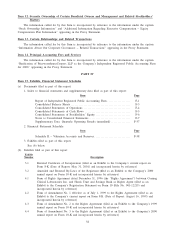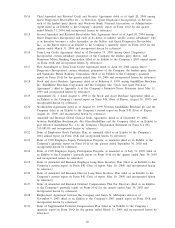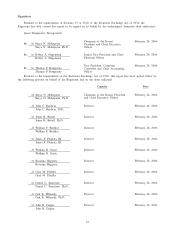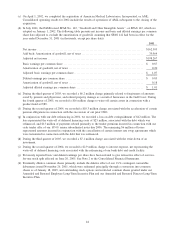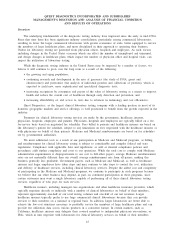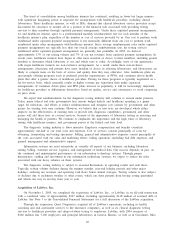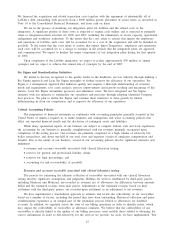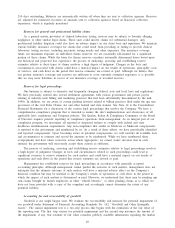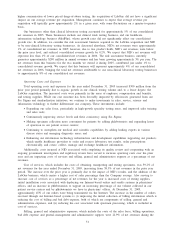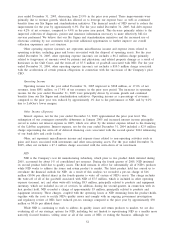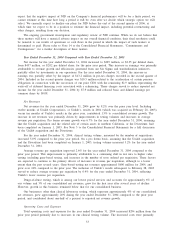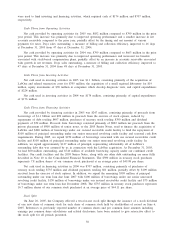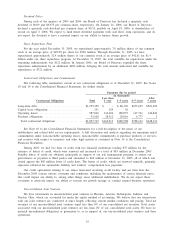Quest Diagnostics 2005 Annual Report Download - page 65
Download and view the complete annual report
Please find page 65 of the 2005 Quest Diagnostics annual report below. You can navigate through the pages in the report by either clicking on the pages listed below, or by using the keyword search tool below to find specific information within the annual report.practices’’ to reduce the number of requisitions that we receive from healthcare providers with missing or
incorrect billing information. Revisions to the allowances for doubtful accounts estimates are recorded as an
adjustment to bad debt expense within selling, general and administrative expenses. We believe that our
collection and allowance estimation processes, along with our close monitoring of our billing operations, help to
reduce the risk associated with material revisions to reserve estimates. Less than 5% of our net accounts
receivable as of December 31, 2005 were outstanding more than 150 days.
Healthcare insurers
Healthcare insurers, including managed care organizations, reimburse us for approximately one-half of our
net revenues. Reimbursements from healthcare insurers are based on negotiated fee-for-service schedules and on
capitated payment rates.
Receivables due from healthcare insurers represent approximately 30% of our net accounts receivable.
Substantially all of the accounts receivable due from healthcare insurers represent amounts billed under
negotiated fee-for-service arrangements. We utilize a standard approach to establish allowances for doubtful
accounts for such receivables, which considers the aging of the receivables and results in increased allowance
requirements as the aging of the related receivables increases. Our approach also considers historical collection
experience and other factors. Collection of such receivables is normally a function of providing complete and
correct billing information to the healthcare insurers within the various filing deadlines. For healthcare insurers,
collection typically occurs within 30 to 60 days of billing. Provided healthcare insurers have been billed
accurately with complete information prior to the established filing deadline, there has historically been little to
no collection risk. If there has been a delay in billing, we determine if the amounts in question will likely go
past the filing deadline, and if so, we will reserve accordingly for the billing.
Approximately 7% of our net revenues are reimbursed under capitated payment arrangements in which case
the healthcare insurers typically reimburse us in the same month services are performed, essentially giving rise
to no outstanding accounts receivable at month-end. If any capitated payments are not received on a timely
basis, we determine the cause and make a separate determination as to whether or not the collection of the
amount from the healthcare insurer is at risk and if so, would reserve accordingly.
Government payers
Payments for clinical laboratory services made by the government are based on fee schedules set by
governmental authorities. Receivables due from government payers under the Medicare and Medicaid programs
represent approximately 15% of our net accounts receivable. Collection of such receivables is normally a
function of providing the complete and correct billing information within the various filing deadlines. Collection
typically occurs within 30 days of billing. Our processes for billing, collecting and estimating uncollectible
amounts for receivables due from government payers, as well as the risk of non-collection, are substantially the
same as those noted above for healthcare insurers under negotiated fee-for-service arrangements.
Client payers
Client payers include physicians, hospitals, employers and other commercial laboratories, and are billed
based on a negotiated fee schedule. Receivables due from client payers represent approximately 30% of our net
accounts receivable. Credit risk and ability to pay are more of a consideration for these payers than healthcare
insurers and government payers. We utilize a standard approach to establish allowances for doubtful accounts
for such receivables, which considers the aging of the receivables and results in increased allowance
requirements as the aging of the related receivables increase. Our approach also considers specific account
reviews, historical collection experience and other factors.
Patient receivables
Patients are billed based on established patient fee schedules, subject to any limitations on fees negotiated
with healthcare insurers or physicians on behalf of the patient. Receivables due from patients represent
approximately 25% of our net accounts receivable. Collection of receivables due from patients is subject to
credit risk and ability of the patients to pay. We utilize a standard approach to establish allowances for doubtful
accounts for such receivables, which considers the aging of the receivables and results in increased allowance
requirements as the aging of the related receivables increases. Our approach also considers historical collection
experience and other factors. Patient receivables are generally fully reserved for when the related billing reaches
48


